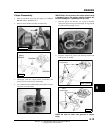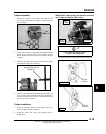
9.19
BRAKES
9
9923142 - 2011 RANGER RZR / RZR S / RZR 4 Service Manual
© Copyright 2010 Polaris Sales Inc.
Pad Inspection
1. Clean the caliper with brake cleaner or alcohol.
2. Measure the thickness of the pad material. Replace pads if
worn beyond the service limit.
Pad Assembly / Installation
1. Lubricate mounting bracket pins with a light film of
silicone grease and install rubber dust boots.
2. Compress mounting bracket and make sure dust boots are
fully seated. Install pads with friction material facing each
other.
3. Install caliper and torque mounting bolts to specification.
4. Slowly pump the brake pedal until pressure has been built
up. Maintain at least 1/2, (12.7 mm) of brake fluid in the
reservoir to prevent air from entering the brake system.
5. Install the adjustment set screw and turn clockwise until the
stationary pad contacts the disc, then back off 1/2 turn.
6. Verify fluid level in reservoir is up to the MAX line inside
reservoir and install reservoir cap.
7. Install wheel and torque wheel nuts to specification.
Brake Burnishing Procedure
It is required that a burnishing procedure be performed after
installation of new brake pads to extend service life and reduce
noise.
Start machine and slowly increase speed to 30 mph. Gradually
apply brakes to stop machine. Allow pads and disc to cool
sufficiently during the procedure. Do not allow pads or disc to
become hot or warping may result. Repeat this procedure 10
times. Do not make more than 3 stops per 1 mile (1.6 km).
Rear Brake Pad Thickness
New .298” ± .007” (7.57 mm ± .178 mm)
Service Limit .180” (4.6 mm)
WARNING
If brake pads are contaminated with grease,
oil, or liquid soaked do not use the pads.
Use only new clean pads.
Measure
Thickness
= T
Rear Caliper Mount Bolt Torque:
18 ft. lbs. (24 Nm)
Master Cylinder Fluid
Up to MAX line inside reservoir
= T
Wheel Nuts:
Steel Wheels: 27 ft. lbs. (37 Nm)
Aluminum Wheels: 30 ft. lbs. + 90° (1/4 turn)
18 ft. lbs.
(24 Nm)


















